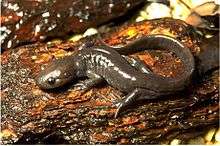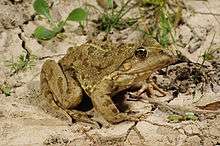Klepton
In biology, a klepton (abbr. kl.) and synklepton (abbr sk.) is a species that requires input from another biological taxon (normally from a species which is closely related to the kleptonic species) to complete its reproductive cycle.[1] Specific types of kleptons are zygokleptons, which reproduce by zygogenesis; gynokleptons which reproduce by gynogenesis, and tychokleptons, which reproduce by a combination of both systems.[2] The term is derived from the Greek, kleptein, "to steal".[3]

Kleptogenic reproduction results in three potential outcomes. A unisexual female may simply activate cell division in the egg through the presence of a male's sperm without incorporating any of his genetic material—this results in the production of clonal offspring. The female may also incorporate the male's sperm into her egg, but can do so without excising any of her genetic material. This results in increased ploidy levels that range from triploid to pentaploid in wild individuals. Finally, the female also has the option of replacing some of her genetic material with that of the male's, resulting in a "hybrid" of sorts without increasing ploidy.[4]
Example
In the wild, five species of Ambystoma salamanders contribute to a unisexual complex that reproduces via a combination of gynogenesis and kleptogenesis: A. tigrinum, A. barbouri, A. texanum, A. jeffersonium, and A. laterale. Over twenty genomic combinations have been found in nature, ranging from "LLJ" individuals (two A. laterale and an A. jeffersonium genome) to "LJTi" individuals (an A. laterale, A. jeffersonium, and an A. tigrinum genome).[4] Every combination, however, contains the genetic information from the A. laterale species, and analysis of mitochondrial DNA has indicated that these unisexual species most likely diverged from an A. barbouri individual some 5 million years ago,[5] making them the oldest unisexual vertebrate species on Earth[6]
_(39586153724).jpg)

_(13667003274).jpg)

01.jpg)
The fact that these salamanders have persisted for so long is remarkable, as it contradicts the notion that a majority of asexual lineages arise when the conditions are right and quickly disappear.[7] It has been argued that this persistence is very much due to the aforementioned "genome replacement" strategy that accompanies kleptogenic reproduction—replacing a portion of the maternal genome with paternal DNA in offspring has allowed unisexual individuals to "refresh" their genetic material through time. This facet of kleptogenesis was recently ascertained from genetic research that indicates there is no ancestral A. laterale genome that is maintained from one unisexual to the next, and that there is not a specific "L" genome that is found more often than others. "L" genetic material found in these salamanders has also not evolved to be substantially unique from sexual genomes.[4]
Examples species exhibiting the property include the water frogs in Europe in the genus Pelophylax.[2]
(P. lessonae × P. ridibundus)

(P. perezi × P. ridibundus)

(P. bergeri × P. ridibundus )
See also
- Gametophytic apomixis, a phenomenon in plants that requires fertilization of the endosperm, but reproduction is clonal
References
- Bogart, J (2009), "An examination of intergenomic exchanges in A. laterale-dependent unisexual salamanders in the genus Ambystoma", Cytogenetic and Genome Research, 124 (4): 44–50, doi:10.1159/000200087, ISSN 1800-427X, PMID 19372668
- Dubois, Alain (2011). "Describing a new species". Taprobanica: The Journal of Asian Biodiversity. 2 (1): 6. doi:10.4038/tapro.v2i1.2703. ISSN 1800-427X.
- Gordh, Gordon; Headrick, David (2011), A Dictionary of Entomology (2 ed.), CABI, Klepton, p.769, ISBN 9781845935429
- Bogart, J (2013), "Genetic and genomic interactions of animals with different ploidy levels", Cytogenetic and Genome Research, 140 (4): 117–136, doi:10.1159/000351593, ISSN 1800-427X, PMID 23751376
- Bogart, J (2007), "Unisexual salamanders (genus Ambystoma) present a new reproductive mode for eukaryotes", Genome, 50 (2): 119–136, doi:10.1139/G06-152, PMID 17546077
- Bi, K (2010), "Time and Time again: unisexual salamanders (genus Ambystoma) are the oldest unisexual vertebrates", BMC Evolutionary Biology, 10 (1): 238, doi:10.1186/1471-2148-10-238, ISSN 1800-427X, PMC 3020632, PMID 20682056
- Lodé, T (2012), "Adaptive Significance and Long-Term Survival of Asexual Lineages" (PDF), Evolutionary Biology, 40 (3): 450–460, doi:10.1007/s11692-012-9219-y
- Dubois, A.; Günther, R. (1982), "Klepton and synklepton: two new evolutionary systematics categories in zoology", Zoologische Jahrbücher, Abteilung für Systematik, Ökologie & Biologie der Tiere, 109: 290–305